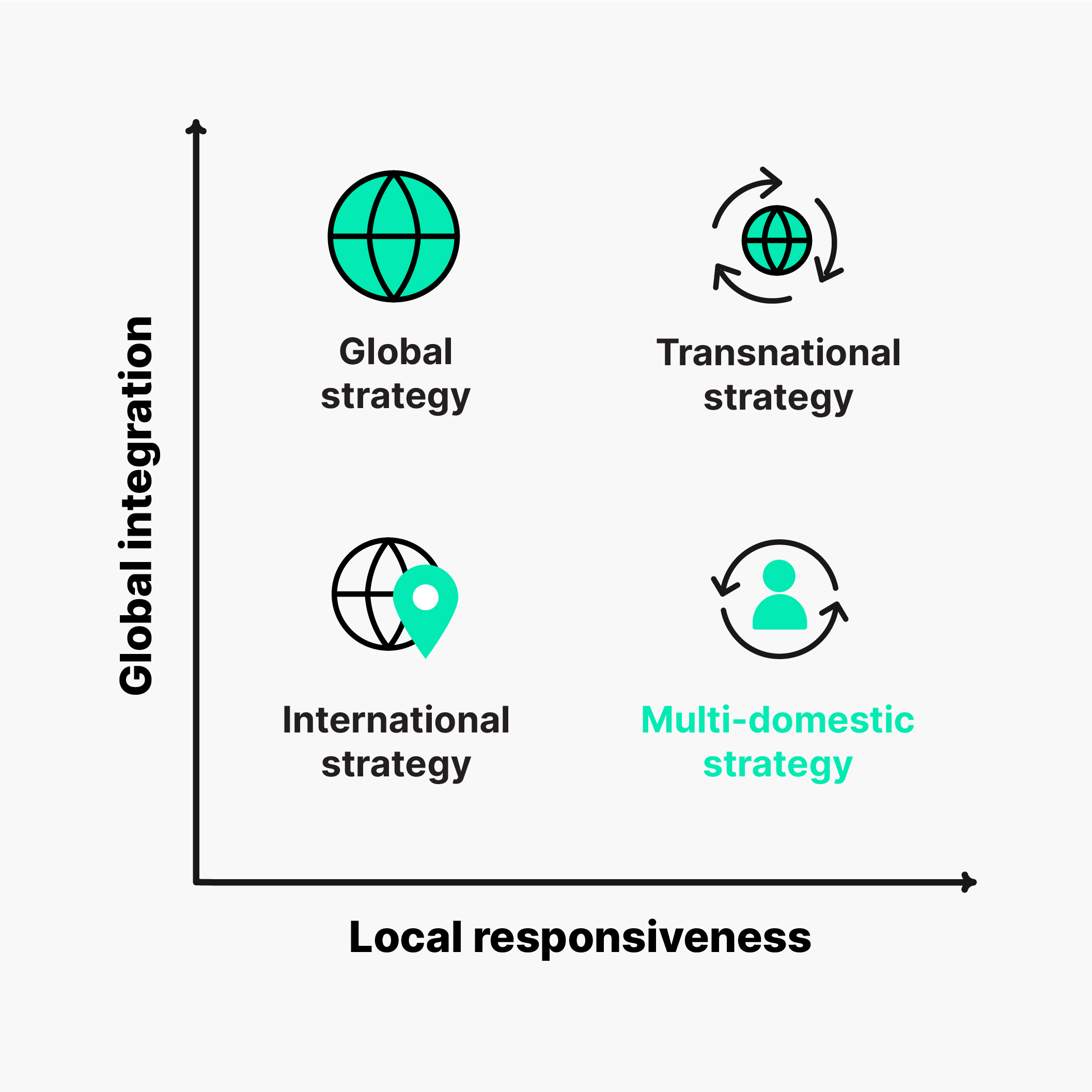Global business
Multi-Domestic Strategy: Key Concepts and Implementation Tips

A multi-domestic strategy is a type of global expansion strategy enabling companies to reach overseas markets with a high degree of responsiveness—prioritizing localization over efficiency and low cost. To help you understand how your business could benefit from a multi-domestic strategy, this guide provides a comparison with other global expansion strategies and includes multi-domestic strategy examples.
What is a multi-domestic strategy?
A multi-domestic strategy is highly local and decentralized, emphasizing high customization of products, services, and the supply chain itself to local needs and preferences. Although a multi-domestic strategy can sacrifice efficiency, companies gain the ability to reach customers in local markets with offerings that more closely reflect community preferences and tastes.
The goal is to build local brands that are competitive and keep operations local to each market. Consumers are presented with a local brand that looks and feels like the product was made by a domestic company.
How a multi-domestic strategy differs from other global expansion strategies
Global expansion strategies offer 4 distinct approaches to global business—with multi-domestic strategy being the most localized strategy of all.

For the other types, varying levels of customization and business structuring allow for greater efficiency but correspondingly less responsiveness to local needs. Since local markets, industries, companies, and goals vary, there’s no one-size-fits-all strategy that fits every company perfectly. Every organization should carefully consider all 4 strategy types and be prepared to adapt a global expansion strategy to fit its unique situation. Skilled adaptation to overseas markets requires the right preparation, professional support, and study.
Global expansion strategies provide a starting point for your business to enter a new international market and appeal to customers in other cultures. Their differences create possibilities for organizations:
International strategy
Organizations using an international strategy don’t extensively adapt to other markets when exporting—keeping operations domestic and not attempting to create a localized brand when offering products and services overseas.
Transnational strategy
For companies following a transnational strategy, efficiency and cost are also important alongside local responsiveness and customization. Transnational firms are typically more centralized and standardized than multi-domestic strategy companies, gaining economies of scale but becoming somewhat less localized than multi-domestic firms as a result.
Global strategy
Instead of being responsive to local preferences, many companies prioritize cost-effective and efficient supply chains—this is known as a global strategy. Economies of scale are used to drive costs as low as possible and products have little-to-no differentiation across different markets.
In essence, customers may buy the same product with a different label. Customization, if any is used, might focus on language translation but keep the features and functionality exactly the same. This makes global strategy nearly the opposite of global strategy since multi-domestic creates brands for each market and global strategy works with a single global brand.
What are the benefits of multi-domestic strategy?
Multi-domestic strategy benefits organizations by allowing them to become local companies, whereas otherwise, they would still be international companies entering the market from overseas. This has unique advantages. Integrated global companies don’t always have a competitive advantage—often, companies choose multi-domestic strategies in markets where the benefits of localization are high.
Operations are local to markets
Essentially, your business can follow a multi-domestic strategy and become a local company in each of the markets where you serve customers. Just like selling in your original domestic market, you create a custom brand and unique local division of your business for each additional country.
Building a brand locally in another market gives your organization operations closer to where customers are. Multi-domestic strategy can help your business save on shipping and transportation costs since any manufacturing, distribution, and business activity is in-country and domestic to the market. You can largely avoid having your operations cross over borders—reducing added expense and regulations affecting international businesses.
Local competitiveness in overseas markets
In your new markets, your multi-domestic company is now a local business. Being a local business is more than simply exporting your products to other markets, and it separates you from other companies trying to gain market share through strategies with less localization.
Multi-domestic strategy allows companies to compete with other local brands in another country, benefitting from the same customer base and opportunities in that region as competitors. In fact, competitiveness in local markets is one of the biggest benefits of choosing a multi-domestic strategy. By cultivating a local brand, your business can reach customers for whom local products have the most appeal.
Top 5 multi-domestic strategy examples
7-Eleven
7-Eleven is the world’s largest chain of convenience stores and has over 60K locations around the globe. In each market, they look closely at what convenience means and offer products and services that meet these needs.
Japanese stores, for instance, help customers pick up and pay for online purchases as well as offer bill pay services, beyond what is typically offered in stores serving American customers.
In some countries, 7-Eleven stores operate as franchises instead of company-owned stores and has used joint venture stores as a strategy for entering some markets, demonstrating that the organization’s strategy for entering overseas markets is flexible and adaptable.
MTV
MTV famously began broadcasting in the 1980s in the US and moved quickly to global markets, with different channels localized to different countries and regions. MTV follows a highly decentralized model, with many channels operating separately for their respective markets.
MTV’s brand and content can differ tremendously by region, catering to the musical tastes of audiences in different parts of the world. For instance, in European countries, MTV channels might still show popular American reality television series but also include popular hits for particular national audiences.
Walgreens Boots Alliance
With over 13K locations, Walgreens Boots Alliance owns brands in 9 different countries. Walgreens is well-known in the US, but GuoDa is a chain in China with more than 8,5K pharmacies—the brands are distinct and operate independently in each region. The parent company also owns pharmaceutical and other health brands, operating a wide-ranging health retail and pharmacy portfolio.
Nestle
A Swiss company focused on food and beverages, Nestle markets brands that are often highly customized to the local market, with many of them only existing in specific countries. With more than 400 factories worldwide, Nestle also localizes production heavily and usually manufactures products in the same country where they are sold and consumed.
Mondelez
Selling food products in over 150 countries, Mondelez brands are highly diverse and local—the company often acquires local brands, keeping them largely the same but adding them to a global portfolio. Customers can purchase the food they are familiar with. In the US, Ritz and Oreo are well-known brands. Another example is Kinh Do Corporation, a subsidiary of Mondelez that produces snack products for the Vietnamese market, including popular local snacks in Vietnam such as Kinh Do Mooncakes.
Benefit from multi-domestic strategy
Identifying the right global expansion strategy for your business requires looking closely at your customers, competitors, goals, and resources. Entering new markets effectively also requires understanding your target market and carefully evaluating challenges and opportunities in your industry.
A multi-domestic strategy helps you compete against popular local brands that are heavily entrenched in local culture. If your brand is unlikely to benefit from competing primarily on cost, a multi-domestic strategy may be particularly invaluable and may enable your company to add a new customer base overseas.




